Introduction: In this article, James Pylant continues telling a “whodunit” story that mystified police and townspeople alike in Weston, Massachusetts, in 1904. James is an editor at GenealogyMagazine.com and author for JacobusBooks.com, is an award-winning historical true-crime writer, and authorized celebrity biographer.
On the afternoon of 31 March 1904, Edward Page came home to find the body of his 41-year-old daughter, Mabel, in her upstairs bedroom in Weston, Massachusetts. Someone mysteriously stabbed her to death and quietly slipped away, unnoticed, in the broad daylight of a small town.
“I cannot understand the murder of my daughter at all, for she had no enemies as far as I know, there was no robbery, and she was not assaulted,” Edward Page told a Boston Herald reporter.
Investigators suspected someone from Mabel’s past: her former fiancé. After their broken engagement, the would-be groom went away “presumably to some foreign country,” as reported by the Boston Journal on April 4:
The police figure that he is still living, and, determined to wreak vengeance on the woman who jilted him almost on their wedding eve, returned quietly and after a stormy scene killed her.

In addition to the former fiancé, a new suspect emerged that same day: Weston resident Charles L. Tucker.
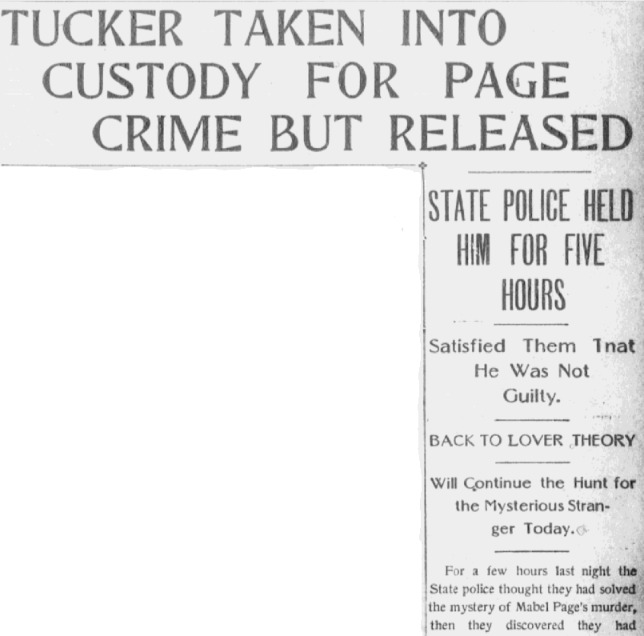
Tucker worked for the same Boston railroad as Mabel’s brother Harold, and he was off duty from work and seen near the Page home at noon on the day of the murder. Tucker was held for suspicion for five hours by state police but then released.
This article reports:
For a few hours last night the state police thought they had solved the mystery of Mabel Page’s murder, then they discovered they had blundered and with due apology released from custody Charles L. Tucker of Weston, whom they had taken on suspicion and held at the Newton police headquarters from about 7 o’clock until after midnight, their investigation during the period of his detention absolutely satisfying them of the completeness of his alibi.
Police then resumed their ex-fiancé theory. However, 15 years had passed since Mabel and her almost-husband parted ways, and the police soon abandoned this theory.
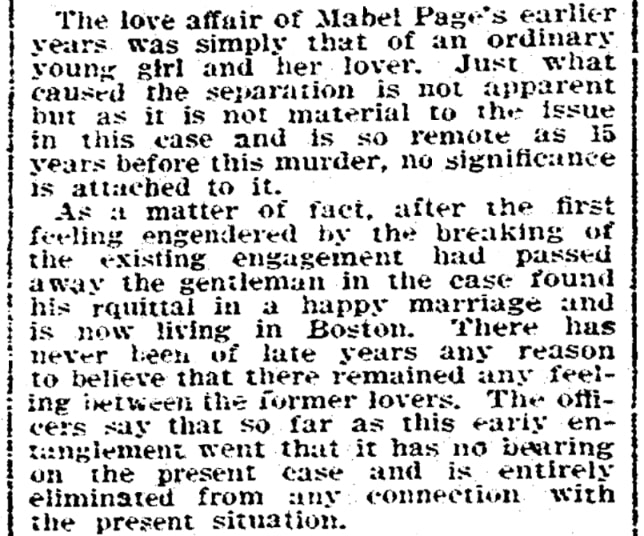
This article reports:
The love affair of Mabel Page’s earlier years was simply that of an ordinary young girl and her lover. Just what caused the separation is not apparent, but as it is not material to the issue in this case and is so remote as 15 years before this murder, no significance is attached to it.
As a matter of fact, after the first feeling engendered by the breaking of the existing engagement had passed away, the gentleman in the case found his requital in a happy marriage and is now living in Boston. There has never been of late years any reason to believe that there remained any feeling between the former lovers. The officers say that so far as this early entanglement went that it has no bearing on the present case and is entirely eliminated from any connection with the present situation.
Other potential suspects surfaced. Around 1 p.m. on the day of Mabel Page’s murder, someone spotted a well-dressed, light-complexioned, light-haired, sandy-mustachioed man walking swiftly from the direction of her home. More than a mile from the Page house, he stopped long enough to whip out a handkerchief and wipe sweat from his forehead before continuing his walk.
“If a strange man tried to get into her house against her protest, there would have been a struggle at the very door,” the Boston Herald opined. Even if the male visitor brought news of her brother’s hospitalization, Mabel “might have invited him into the parlor.” Still, she would’ve dismissed him before going upstairs to change clothes for the trip to Boston. The newspaper surmised the killer was a woman, one Mabel knew as a friend who “glided into the room behind her unsuspecting victim, to strike as the snake strikes its unresisting prey.”
Gossip pointed a finger at the maid, Amy Roberts, saying she and Mabel “were not on the best of terms” and that the two had confrontations. However, these stories proved false, and state police eliminated the maid as a suspect.
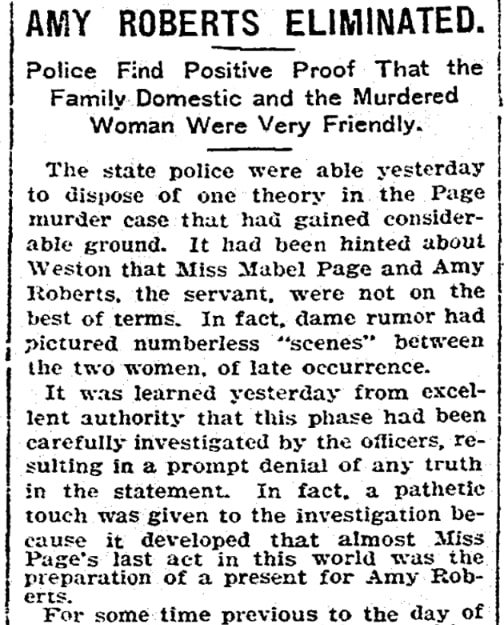
Then the police investigation took an unexpected turn. On Saturday night, April 9, 22-year-old Charles L. Tucker – just days after being questioned and released – was arrested for Mabel Page’s murder. “Tucker has told conflicting stories of his whereabouts on the day of the murder,” the Boston Herald reported the day after his arrest.
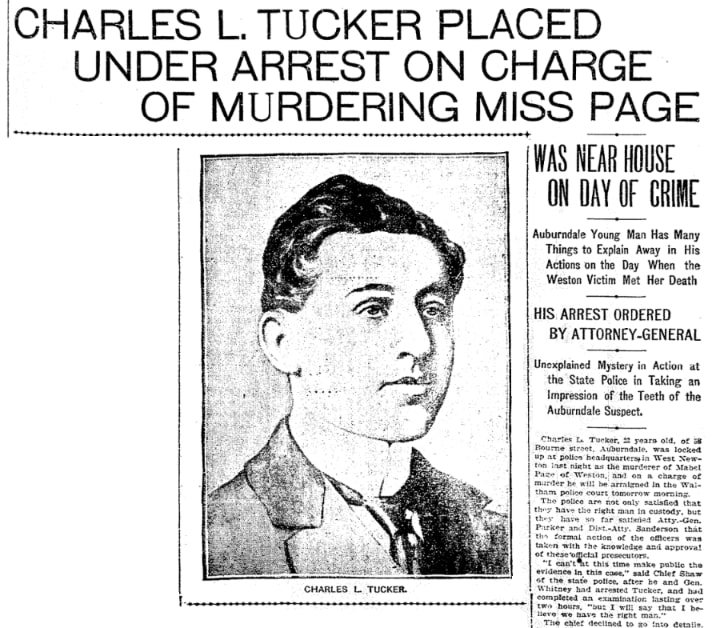
The Herald’s extensive coverage reported “numerous incidents in the life of young Tucker which gave him the stamp of a criminal.” While employed at a boathouse, he was accused of twice stealing from the cashbox, and he later admitted to forging his employer’s signature on a $150 check. However, the close friendship between the employer and Tucker’s father kept the young man from being jailed, along with a promise to make restitution.
On 21 April 1903, during that employment, Tucker’s wife brought lunch for her husband at work during the noon hour. The two paddled in a canoe up the Charles River for a picnic. At 2 p.m., Tucker returned an hour late to work, soaking wet, and explained that the canoe had capsized while he and his wife were changing seats and that she had drowned. Police didn’t believe Tucker’s story, but there were no other witnesses to the drowning.
As the investigation into Tucker continued, new facts were released to the press.
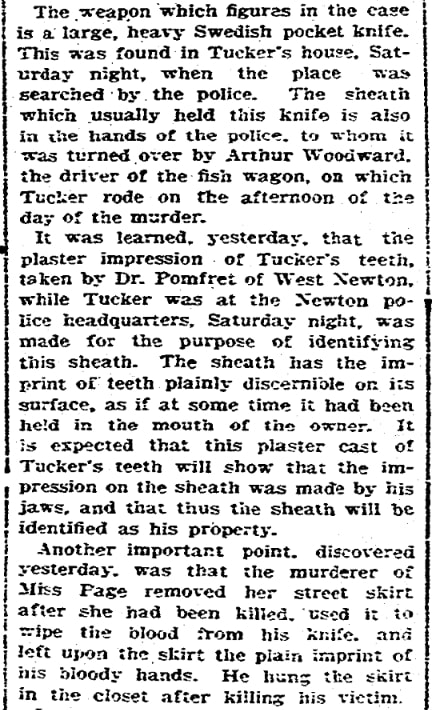
This article reports:
The weapon which figures in the case is a large, heavy Swedish pocket knife. This was found in Tucker’s house Saturday night when the place was searched by the police. The sheath which usually held this knife is also in the hands of the police, to whom it was turned over by Arthur Woodward, the driver of the fish wagon on which Tucker rode on the afternoon of the day of the murder.
It was learned yesterday that the plaster impression of Tucker’s teeth, taken by Dr. Pomfret of West Newton, while Tucker was at the Newton police headquarters Saturday night, was made for the purpose of identifying this sheath. The sheath has the imprint of teeth plainly discernible on its surface, as if at some time it had been held in the mouth of the owner. It is expected that this plaster cast of Tucker’s teeth will show that the impression of the sheath was made by his jaws, and that thus the sheath will be identified as his property.
Another important point discovered yesterday was that the murderer of Miss Page removed her street skirt after she had been killed, used it to wipe the blood from his knife, and left upon the skirt the plain imprint of his bloody hands. He hung the skirt in the closet after killing his victim.
Tucker admitted to breaking the knife – which he had first denied owning – because he didn’t want investigators to find it. At his formal arraignment on April 11, the accused appeared nonchalant as he pleaded not guilty.
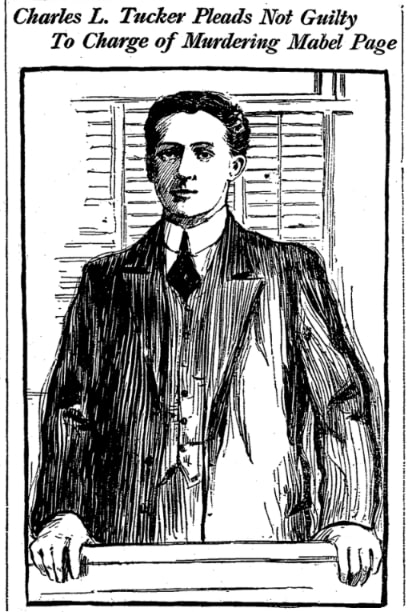
The murder trial unfolded in the Middlesex Superior Court in East Cambridge on 2 January 1905. District Attorney George A. Sanderson told jurors that Mabel Page’s killer stabbed her to death in the second-floor hallway and then dragged the body into her bedroom, that money was stolen from Mabel’s purse, and that a Canadian-made pin “of peculiar pattern” found in Tucker’s coat pocket, was positively identified as a pin known to have been in Mabel’s cushion a day before her murder.
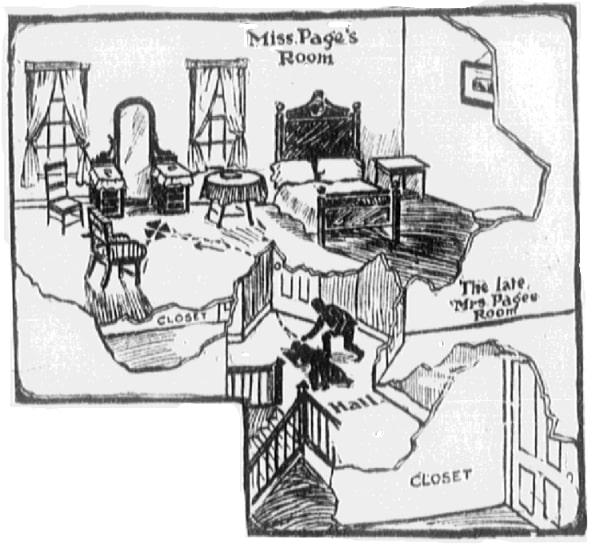
Sanderson said that someone stole a ten-dollar bill, two one-dollar bills, and possibly more from Mabel’s purse and that Tucker was seen holding a ten-dollar bill in a store. He added that Tucker wrote – in a disguised handwriting – a note stating “J. L. Morton, Charlestown, Mass.” on a slip of paper found near the murdered woman’s body.
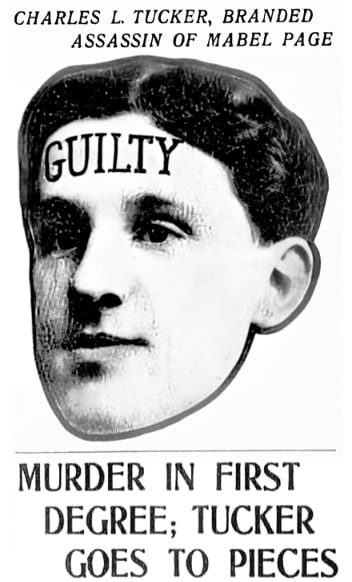
The trial ended on January 24 with jurors finding Charles L. Tucker guilty of first-degree murder, called “the most startling verdict ever heard in a Massachusetts courtroom” by the Boston Journal. “He blindly grasped the rail in front of him, steadied himself a moment and then collapsed in his chair,” noted a reporter.
Still, “the greatest murder mystery Massachusetts has ever known” would continue to make newspaper headlines with unexpected twists and turns.
To be continued…
Explore over 330 years of newspapers and historical records in GenealogyBank. Discover your family story! Start a 7-Day Free Trial
Note on the header image: Sherlock Holmes investigates a mystery.
Illustration credit: https://depositphotos.com/home.html
Related Article:
